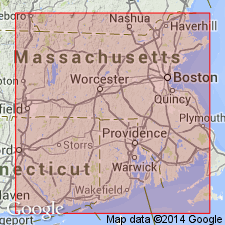
- Usage in publication:
-
- Rhode Island Formation*
- Modifications:
-
- Overview
- AAPG geologic province:
-
- New England province
Summary:
Authors use Rhode Island Formation. Consists of sandstone, graywacke, shale, and conglomerate, minor beds of meta-anthracite, and fossil plants. Also includes separately mapped informal unit consisting of conglomerate, sandstone, and graywacke. Age is Middle and Late Pennsylvanian.
Source: GNU records (USGS DDS-6; Reston GNULEX).

- Usage in publication:
-
- Rhode Island Group, Formation
- Modifications:
-
- Revised
- AAPG geologic province:
-
- New England province
Summary:
Author here assigns the Sachuest Arkose, Purgatory Conglomerate, Pondville Conglomerate, Wamsutta Formation, Rhode Island Formation, and Dighton Conglomerate to the Rhode Island Group of northern Rhode Island and southeastern Massachusetts. Encompasses rocks of Pennsylvanian age in the southern and northern Narragansett basins and the Norfolk basin. Maximum thickness of the group is 3,000 m, the thickness of the Rhode Island Formation, which makes up most of the Narragansett basin. Based on megaflora and microfauna, age ranges from Westphalian A or B (Early to Middle Pennsylvanian) to Stephanian B or C (Late Pennsylvanian).
[Usage of the Rhode Island in this report is not recommended. According to Article 19f of the NACSN code (1983), "In changing the rank of a unit, the same name may not be applied both to the unit as a whole and to a part of it." In 1979, Skehan and Murray provisionally assigned the Rhode Island Formation to the Narragansett Bay Group. Rhode Island Group of this report no doubt replaces the Narragansett Bay, which has never been formally defined. Incidental use of Narragansett Basin Group and Rhode Island Bay Group in previous reports by the same authors are most likely errors.]
Source: GNU records (USGS DDS-6; Reston GNULEX).

- Usage in publication:
-
- Rhode Island Formation*
- Modifications:
-
- Overview
- AAPG geologic province:
-
- New England province
Summary:
Rhode Island Formation is thickest and most extensive formation in Narragansett basin. Does not extend to Norfolk basin. Consists of gray sandstone and siltstone and lesser amounts of gray to black shale, gray conglomerate, and coal beds 10 m thick. Interfingers with Wamsutta Formation in Narragansett basin. In places overlies Dedham Granite. Age is Middle and Late Pennsylvanian. Report includes geologic maps, correlation charts. [Chapters A-J in U.S. Geological Survey Professional Paper 1366 are intended as explanations and (or) revisions to the 1:250,000-scale MA State bedrock geologic map of Zen and others (1983).]
Source: GNU records (USGS DDS-6; Reston GNULEX).
For more information, please contact Nancy Stamm, Geologic Names Committee Secretary.
Asterisk (*) indicates published by U.S. Geological Survey authors.
"No current usage" (†) implies that a name has been abandoned or has fallen into disuse. Former usage and, if known, replacement name given in parentheses ( ).
Slash (/) indicates name conflicts with nomenclatural guidelines (CSN, 1933; ACSN, 1961, 1970; NACSN, 1983, 2005, 2021). May be explained within brackets ([ ]).

